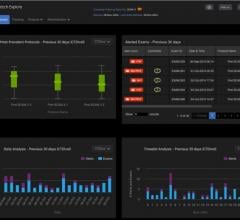
There is a basic need to share data outside of diagnostic imaging, and a CVIS should be able to simplify access.
During my years as an infrastructure architect at a large health system in Iowa, I had a top down view of the parts that make up an application solution. In the case of picture archiving and communications systems (PACS), that meant assembling the people, pieces and technology that go into rolling out imaging to radiology, cardiology, oncology and so on. I have asked the same questions many of you do — questions such as: Where is the data? How do clinicians get to it? Who owns it? How do we protect it? What is the optimal solution design? When you can address these basic questions, then you can determine how to make the information available so it is not only fluid, but requires a minimal amount of resources. However, we often get so caught up in the details of what to do at the department level to improve workflow that the big picture of how to spread imaging to the entire enterprise is lost. When considering when and where to store and access the vast amount of data, you cannot miss the forest for the trees.
Leveraging Vendor-Neutral Archives
Many healthcare systems are finding themselves in the same situation. Their general PACS and cardiology PACS are both aging, their image storage is reaching capacity, and the budget has been allocated for the implementation of an electronic health record (EHR) solution. In this climate, how do the diagnostic imaging departments address the needs of their cardiologists and radiologists, the needs of other clinicians and patients for automated, reliable information at the point of care as well as the hospital’s business needs to achieve meaningful use for their EHR? The trend in the industry has been to separate the PACS application from the image data and workflow engines, earning the title of vendor neutral archive. When I hear this terminology, I tend to cringe. Can a vendor ever be neutral? Of course not. But the image repository or archive can be neutral. That is why I prefer the term PACS neutral archive. Instead of locking you into a specific imaging system, images can be stored and retrieved from the neutral archive because it was built to exchange data with disparate systems. The basic need — to share data outside the walls of diagnostic imaging — becomes more important as organizations continue implementing EHRs. Imaging, of course, is a key component to providing the complete picture of the patient’s health, and in the same respect being able to simplify access to those images becomes more and more paramount to facilitating the care continuum.
Earlier this year, when leaders at Methodist Le Bonheur Healthcare (MLH), a not-for-profit health system based in Memphis, Tenn., saw the opportunity to standardize their suite of diagnostic imaging solutions, they capitalized on it. The seven-hospital system made the decision to deploy McKesson’s portfolio of enterprise medical imaging products across its various facilities to help improve physician collaboration, streamline data management and simplify its imaging archive process with a single point of access.
“By deploying these solutions together, we can improve workflow efficiency for our clinicians and decrease the complexity of our current IT infrastructure,” said Alastair MacGregor, senior vice president and chief healthcare information officer, Methodist Le Bonheur Healthcare. “In doing so, we expect to reduce our cost of ownership. We also will be able to consolidate information that’s essential for making diagnoses, which will enable our medical and clinical staff to make more informed decisions faster.”
MLH will leverage McKesson Enterprise Image Repository, a PACS neutral archive, and McKesson Study Share, a Web-based knowledge management system, to help simplify enterprise-wide access to imaging information from both McKesson Radiology and McKesson Cardiology. Physicians will now have the ability to chat, launch a context-sensitive case for review, agree or disagree on the assessment, and immediately go back to their normal workflow from any computer. The ability to launch studies from either system with immediate notifications will help improve image management and staff collaboration. By reducing the complexity of interfaces across the enterprise, MLH plans to not only be able to improve decision support, but will also be able to lower the costs associated with interfaces and help decrease the need for future migrations.
Consider the Architecture of the System
Whether you have already implemented an EHR or are about to undertake an implementation, it is important to establish an architecture that syncs the workflow and technology solutions with the management of the image archive. There should also be consideration to expand the manageability and size of the archive to include all imaging sources and types. The architecture should allow the site to leverage and choose whatever cardiology, radiology or other ology system that fits their workflow and business needs while at the same time using the enterprise archive technology to connect the entire imaging enterprise.
Now is the right time to look at your organization’s global imaging archive strategy. Besides the complexity of adding EHRs, healthcare organizations must also navigate the waters of continually growing image volume and the rapid consumption of imaging resources. All of these business challenges can be minimized with the right archive architecture and workflow solution.
The paths to an enterprise archive and data access may not be identical for everyone, but every long-term strategy should consider the forest as well as the trees.
About the author: Thomas Coppa has many years of experience working on the enterprise IT team at Iowa Health System as an infrastructure architect, and was part of a team that led the charge toward an enterprise-wide solution for image data management. Currently, he is the technical consultant with McKesson Enterprise Image Repository.


 December 17, 2015
December 17, 2015 
